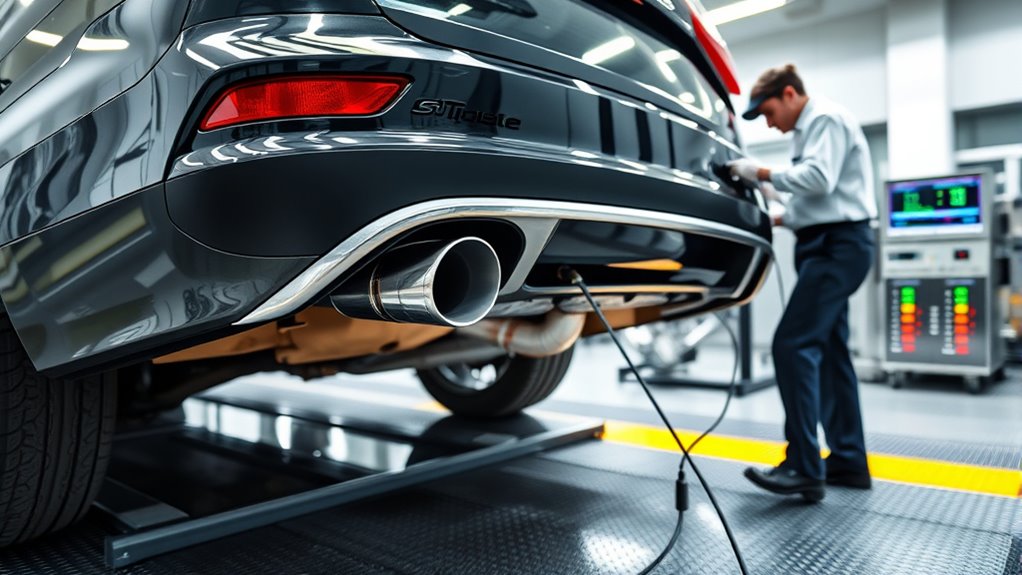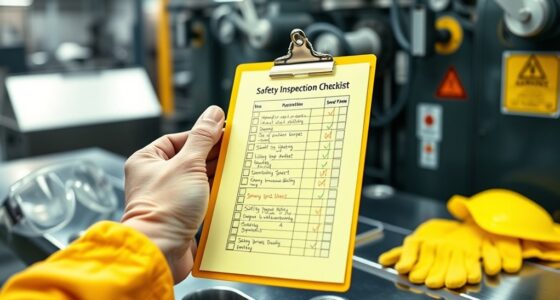Emissions testing looks for your vehicle’s levels of pollutants like carbon monoxide, hydrocarbons, and nitrogen oxides, which can harm air quality. It checks if your vehicle’s emissions stay within legal limits by analyzing gases from the tailpipe during engine operation. The test also assesses how well components like the catalytic converter and onboard diagnostic system work to reduce emissions. If you’re curious about how these systems keep your car compliant, keep exploring to learn more.
Key Takeaways
- Measurement of vehicle’s pollutant levels, including CO, HC, and NOx, during engine operation.
- Checking if emissions exceed legal limits set by environmental regulations.
- Inspection of catalytic converter performance to ensure proper pollutant conversion.
- Monitoring of onboard diagnostic (OBD II) system for fault codes and system health.
- Verification that emission control components are functioning correctly through visual and functional tests.

Have you ever wondered how your vehicle’s emissions are measured and why it matters? When you take your car in for an emissions test, the process is designed to safeguard your vehicle isn’t releasing excessive pollutants into the air. Central to this process are components like catalytic converters and the onboard diagnostic systems, such as OBD II, which play essential roles in monitoring and controlling emissions. Understanding what emissions testing looks for can help you grasp why these components are critical and how they work together to keep your car compliant and environmentally friendly.
During testing, your vehicle’s exhaust gases are analyzed to check for specific pollutants, including carbon monoxide (CO), hydrocarbons (HC), and nitrogen oxides (NOx). These are the primary emissions that contribute to smog, acid rain, and health problems. The testing process often involves a tailpipe sniffer that captures exhaust fumes while the engine runs at various speeds, providing real-time data on pollutant levels. If the levels exceed the legal limits, your vehicle may need repairs before passing inspection. This is where the significance of the catalytic converter becomes clear. The catalytic converter’s job is to convert harmful gases like CO and HC into less harmful substances such as carbon dioxide and water vapor. Without a properly functioning catalytic converter, your emissions will be higher, and the vehicle may fail the test.
Exhaust analysis detects pollutants; catalytic converters reduce harmful gases to pass emissions tests and protect air quality.
In addition to exhaust analysis, modern testing relies heavily on the OBD II system, which continuously monitors your vehicle’s emission-related components and sensors. If a malfunction occurs—say, an issue with the oxygen sensors or the catalytic converter itself—the OBD II system detects it and stores a trouble code. When you bring your car in for emissions testing, the technician will connect a scan tool to check for these codes, giving insight into potential problems that could cause emissions to spike. A vehicle with a clean OBD II report typically has a better chance of passing the test because it indicates all monitored systems are functioning properly. Regular maintenance and automated monitoring systems are essential for ensuring ongoing compliance.
Ultimately, emissions testing looks for proof that your vehicle’s emissions control systems are working correctly. It’s not just about passing a test; it’s about reducing pollution and protecting air quality. Components like catalytic converters and the OBD II system are central to this effort. They ensure that your vehicle runs cleaner and complies with environmental standards. By understanding what emissions testing involves and how these systems operate, you can better appreciate how your car contributes—or detracts—from cleaner air. Regular maintenance and timely repairs help keep these systems in top shape, making sure your vehicle stays efficient, compliant, and environmentally responsible.
Frequently Asked Questions
How Often Should I Get My Vehicle Tested?
You should get your vehicle tested every one to two years, depending on your state’s inspection frequency requirements. Check local testing locations to find authorized facilities nearby. Regular testing guarantees your vehicle meets emissions standards, helping you avoid fines and contributing to cleaner air. Keep track of your vehicle’s last inspection date and schedule future tests accordingly to stay compliant and maintain good vehicle health.
What Happens if My Vehicle Fails Emissions Testing?
A stitch in time saves nine, so if your vehicle fails emissions testing, you face failure consequences like costly repairs or registration delays. You’ll need to address the issues causing the failure and follow re-test procedures, which often involve fixing the problem and returning for a second test. Acting promptly can save you time and money, ensuring your vehicle remains compliant and environmentally friendly.
Are Emissions Tests Required for Electric Vehicles?
Electric vehicles typically aren’t required to undergo emissions testing because they produce no tailpipe emissions. This exemption is part of emissions testing regulations aimed at reducing pollution. If you’re interested, electric vehicle incentives are available in many areas to encourage adoption. You can benefit from lower registration fees and tax credits, which make switching to an electric vehicle more affordable. Always check local regulations to confirm specific requirements in your area.
How Long Does an Emissions Test Typically Take?
An emissions test typically takes about 20 to 30 minutes. During the process, you’ll use emissions equipment to measure your vehicle’s exhaust emissions. The testing procedures involve running your car through a series of checks to make certain it meets local standards. The technician will monitor emissions equipment, analyze the data, and determine if your vehicle passes or needs repairs. It’s a quick, straightforward process designed to keep air clean.
Can I Drive My Car After a Failed Emissions Test?
Think of the inspection process like a health check-up—you wouldn’t overlook a warning. After a failed emissions test at the test station, you can’t drive your car legally until you fix the issues. Just like you wouldn’t ignore symptoms, addressing the problem ensures your vehicle passes the next inspection. Driving without passing can lead to fines, so it’s best to get repairs done promptly before hitting the road again.
Conclusion
Think emissions testing is just about checking your car’s pollution levels? Actually, it’s more like uncovering hidden problems that could be damaging your engine and the environment. Some say it’s unnecessary, but studies show regular testing reduces harmful emissions and keeps your vehicle running smoothly. So, next time you get tested, remember you’re not just passing a check—you’re helping protect the planet and ensuring your car stays in top shape. Trust the process; it’s worth it.









